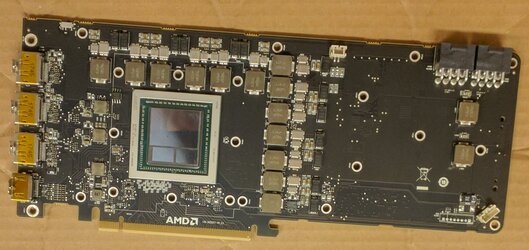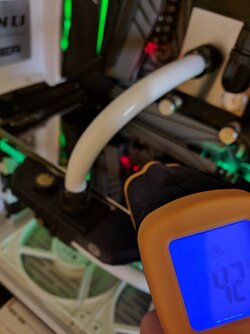- Joined
- Jun 21, 2002
I think I'll just bite the bullet for that then. SuperPosition works well too, but it would be nice to have the comparison with different reviews 
I was literally going to ask you where you found your hot spot temp in HWiNFO64, because I have been wondering if that's been impacting my performance at all, and I just now looked at my GPU in that program. It's the third one. It's been there the whole time. : I wonder if I can get that to read out in my OSD (still been using Afterburner for the OSD, maybe this is a good opportunity to set up the HWiNFO64 OSD). After a cursory search engine review, it looks like the hot spot might be difficult to isolate. Mine is 11C warmer than the GPU temp running F@H with 1050mV. Switching to a 1200mV OC profile and running heaven for a few minutes, HBM and "core" stay at 45C, however hotspot reads 20C above that at 65C, possibly well into throttling territory.
: I wonder if I can get that to read out in my OSD (still been using Afterburner for the OSD, maybe this is a good opportunity to set up the HWiNFO64 OSD). After a cursory search engine review, it looks like the hot spot might be difficult to isolate. Mine is 11C warmer than the GPU temp running F@H with 1050mV. Switching to a 1200mV OC profile and running heaven for a few minutes, HBM and "core" stay at 45C, however hotspot reads 20C above that at 65C, possibly well into throttling territory.
I was literally going to ask you where you found your hot spot temp in HWiNFO64, because I have been wondering if that's been impacting my performance at all, and I just now looked at my GPU in that program. It's the third one. It's been there the whole time.
 : I wonder if I can get that to read out in my OSD (still been using Afterburner for the OSD, maybe this is a good opportunity to set up the HWiNFO64 OSD). After a cursory search engine review, it looks like the hot spot might be difficult to isolate. Mine is 11C warmer than the GPU temp running F@H with 1050mV. Switching to a 1200mV OC profile and running heaven for a few minutes, HBM and "core" stay at 45C, however hotspot reads 20C above that at 65C, possibly well into throttling territory.
: I wonder if I can get that to read out in my OSD (still been using Afterburner for the OSD, maybe this is a good opportunity to set up the HWiNFO64 OSD). After a cursory search engine review, it looks like the hot spot might be difficult to isolate. Mine is 11C warmer than the GPU temp running F@H with 1050mV. Switching to a 1200mV OC profile and running heaven for a few minutes, HBM and "core" stay at 45C, however hotspot reads 20C above that at 65C, possibly well into throttling territory.
